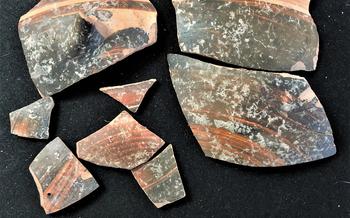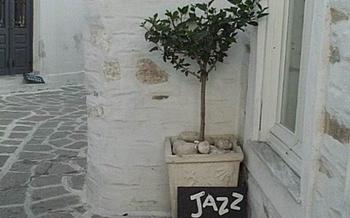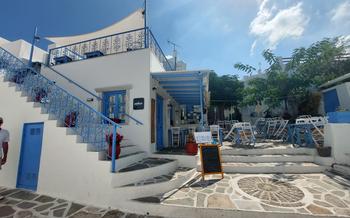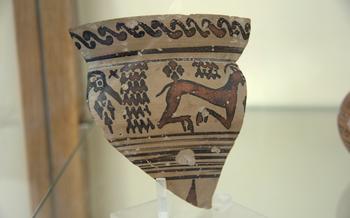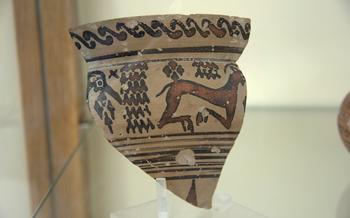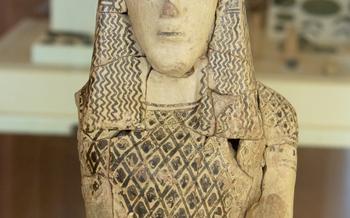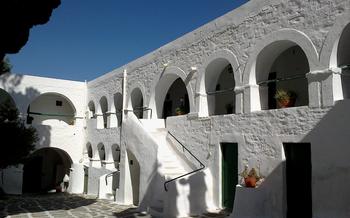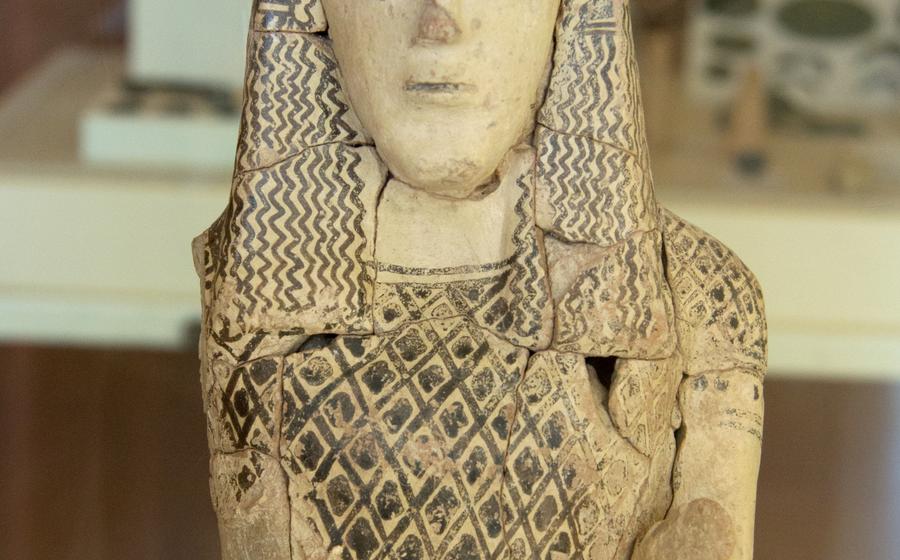
Damianos Folklore Collection
- Historical Background
- Exhibits: A Journey Through Greek Traditions
- Interactive Displays
- Guided Tours
- Workshops and Demonstrations
- Cultural Events
- Educational Programs
- Accessibility:
- Photography and Videography:
- Souvenirs and Gifts
- Operating Hours and Fees:
- Visitor Etiquette
- Insider Tip:
Historical Background
The Damianos Folklore Collection is a testament to the enduring spirit advocate for preserving traditional ways of life, the museum houses a treasure trove of artifacts that tell the story of Paros's rich past. Damianos's unwavering dedication to safeguarding the island's cultural identity inspired him to embark on a journey to collect and document the everyday objects, tools, and customs that were rapidly disappearing due to modernization. Through his tireless efforts, the museum now stands as a living testament to the resilience and continuity of Greek traditions.
Exhibits: A Journey Through Greek Traditions
The Damianos Folklore Collection showcases a diverse range of exhibits that provide visitors with a glimpse into the rich cultural heritage of Paros and Greece. From traditional costumes and textiles to intricate embroidery and woven goods, the museum houses an array of artifacts that tell the story of the island's past.
Among the most notable exhibits are the beautifully preserved traditional costumes, meticulously crafted with vibrant colors and intricate designs. These costumes represent the diverse regions of Greece, each with its own unique style and symbolism. Visitors can admire the elaborate wedding dresses, adorned with delicate lace and embroidery, as well as the everyday garments worn by farmers, fishermen, and shepherds, reflecting their distinct lifestyles and occupations.
Another highlight of the collection is the impressive display of woven goods, showcasing the exceptional skills of Paros's weavers. From colorful rugs and blankets to intricate tapestries and wall hangings, these textiles demonstrate the island's mastery of this traditional craft. The intricate patterns and motifs woven into these pieces hold cultural significance, representing ancient symbols, mythological figures, and scenes from everyday life.
The museum also features a collection of agricultural tools and implements, providing insight into the traditional farming practices of Paros. Visitors can examine plows, sickles, and other tools used for cultivating the land, as well as traditional methods of harvesting and processing crops. These exhibits highlight the importance of agriculture in the island's history and its role in shaping the lives of its people.
Interactive Displays
The Damianos Folklore Collection features several interactive and multimedia displays that bring the past to life and enhance the visitor experience. These displays allow visitors to engage with the exhibits in a hands-on and immersive way, gaining a deeper understanding of traditional Greek culture.
One of the most popular interactive displays is a virtual reality experience that transports visitors back in time to witness traditional Greek dances, festivals, and everyday life. Visitors can don VR headsets and immerse themselves in these vibrant scenes, feeling as if they've stepped back in time.
Another interactive display features a collection of traditional musical instruments. Visitors can pick up these instruments and play them, learning about their unique sounds and roles in Greek music. This hands-on experience allows visitors to connect with the musical heritage of Paros and Greece.
The museum also has a touch-screen kiosk that provides in-depth information about the exhibits. Visitors can explore the collection at their own pace, learning about the history, significance, and cultural context of each artifact.
These interactive displays add a modern and engaging element to the museum experience, making it accessible and enjoyable for visitors of all ages. They provide a deeper understanding of traditional Greek culture and create lasting memories for visitors.
Guided Tours
The Damianos Folklore Collection offers guided tours that provide an immersive and educational experience for visitors. These tours are led by knowledgeable and passionate guides who share their insights into the history, significance, and cultural context of the exhibits. By taking a guided tour, visitors can gain a deeper understanding of traditional Greek culture and the role it played in shaping the identity of Paros.
Guided tours are available in various languages, including English, French, German, and Greek. Visitors can book a tour in advance to ensure a spot, especially during peak tourist season. Additional fees may apply for guided tours, but they are well worth the investment for a more personalized and enriching experience.
During the tour, visitors will be taken on a journey through the different sections of the museum, where they will learn about the traditional crafts, customs, and lifestyle of the Parians. The guides will point out the most notable artifacts and explain their cultural significance, providing visitors with a deeper understanding of the rich heritage of the island.
Workshops and Demonstrations
The Damianos Folklore Collection offers a unique opportunity for visitors to engage in hands-on experiences through workshops and demonstrations. These activities provide an immersive journey into traditional Greek crafts and customs, allowing visitors to learn from skilled artisans and gain firsthand knowledge of the techniques and practices that have been passed down for generations.
Some of the workshops offered include traditional weaving, pottery, and embroidery. Participants can learn the basics of these crafts, try their hand at creating their own pieces, and take home a tangible souvenir of their experience.
Demonstrations are also regularly held, showcasing the expertise of local craftsmen and women. Visitors can watch as artisans demonstrate their skills in wood carving, metalworking, and other traditional crafts, gaining insights into the intricate processes involved and the dedication required to master these skills.
The workshops and demonstrations are a fantastic way to connect with the local culture and traditions of Paros. They provide a unique opportunity to learn from the masters, immerse oneself in the creative process, and appreciate the artistry and craftsmanship that goes into traditional Greek handicrafts.
Personal Anecdote:
During my visit to the museum, I had the privilege of participating in a traditional weaving workshop. Under the guidance of a skilled weaver, I learned the basics of the craft and tried my hand at creating a small woven piece. The experience was both challenging and rewarding, and I gained a newfound appreciation for the skill and patience required to create these beautiful textiles.
Cultural Events
The Damianos Folklore Collection is not merely a repository of artifacts; it is a vibrant hub that actively promotes traditional Greek culture through engaging cultural events and festivals throughout the year. These events provide a unique opportunity for visitors to immerse themselves in the rich heritage of Paros and Greece.
One of the highlights is the annual Traditional Dance Festival, which showcases the vibrant folk dances of various regions in Greece. Talented dance troupes perform energetic and graceful routines, accompanied by live music and colorful costumes. The atmosphere is electric as the dancers twirl and stomp to the beat, captivating the audience with their passion and skill.
Another popular event is the Paros Crafts Fair, where local artisans and craftsmen showcase and sell their handmade creations. Visitors can browse intricate pottery, woven textiles, leather goods, and more, all while supporting the local community. The fair offers a glimpse into the traditional crafts that have been passed down through generations, preserving the essence of Greek culture.
For those interested in culinary delights, the Traditional Food Festival is a must-attend event. Visitors can savor a variety of traditional Greek dishes, from savory pies and grilled meats to mouthwatering pastries. The festival is a celebration of the island's rich gastronomic heritage, where visitors can indulge in authentic flavors and learn about the culinary traditions of Paros.
These cultural events are not just spectacles; they are living expressions of Greek culture, providing visitors with an immersive and interactive experience. Whether you are a history buff, a dance enthusiast, or a foodie, there is something for everyone at the Damianos Folklore Collection's cultural events.
Educational Programs
The Damianos Folklore Collection is committed to educating the younger generation about Greek heritage and traditions. To this end, the museum offers a variety of educational programs and outreach initiatives throughout the year. These programs are designed to engage students of all ages in interactive and hands-on learning experiences that bring the past to life.
One of the most popular programs is the "History Detectives" workshop, which invites students to explore the museum's collection and uncover the stories behind the artifacts. Through hands-on activities and interactive storytelling, students learn about the different aspects of Greek culture and history.
The museum also offers guided tours specifically tailored for school groups. These tours are led by experienced educators who provide in-depth explanations of the exhibits and their cultural significance. Students are encouraged to ask questions and engage in discussions, fostering a deeper understanding of Greek heritage.
The success of these educational programs is evident in the testimonials from participants. Many students have expressed their appreciation for the opportunity to learn about Greek culture in a fun and engaging way. One student remarked, "I never knew history could be so interesting! I learned so much about my country and its traditions."
These educational initiatives play a vital role in ensuring that the younger generation is aware of their cultural roots and the importance of preserving their heritage. By fostering a love of history and tradition, the Damianos Folklore Collection is helping to shape the future of Greece.
Accessibility:
The Damianos Folklore Collection is committed to providing an inclusive and accessible experience for all visitors, regardless of their abilities. Wheelchair ramps and elevators ensure that the museum is fully accessible to visitors with mobility challenges. Additionally, audio guides are available for visitors who are deaf or hard of hearing, providing a comprehensive and immersive experience. The museum staff is also trained to assist visitors with disabilities and ensure that they have a comfortable and enjoyable visit.
One of my most heartwarming experiences at the museum was witnessing the joy on the face of a young girl in a wheelchair as she explored the exhibits. Accompanied by her parents, she was able to navigate the museum with ease, thanks to the accessible ramps and elevators. The staff was incredibly welcoming and helpful, providing her with an audio guide that catered to her needs. It was truly inspiring to see how the museum's commitment to accessibility allowed her to fully engage with the collection and appreciate the richness of Greek culture.
Photography and Videography:
The Damianos Folklore Collection welcomes visitors to capture the beauty and essence of the exhibits through photography and videography. However, to preserve the integrity of the artifacts and the overall museum experience, certain guidelines must be followed. Flash photography is strictly prohibited, as it can damage the delicate fabrics and materials of the exhibits. Tripods and other photography equipment are allowed, but visitors are requested to be mindful of other guests and not obstruct their views. For professional photography or videography projects, prior permission from the museum management is required. Whether you're a casual tourist or a professional photographer, remember to respect the rules and capture the essence of the Damianos Folklore Collection responsibly.
Souvenirs and Gifts
The Damianos Folklore Collection features a quaint gift shop that offers a delightful array of souvenirs and gifts inspired by the museum's exhibits. Visitors can browse through a charming selection of handcrafted items, traditional Greek artifacts, and unique souvenirs that celebrate the rich cultural heritage of Paros.
From intricately painted ceramics and woven textiles to replicas of ancient jewelry and miniature sculptures, there's something for every taste and budget. These souvenirs serve as tangible reminders of the museum's treasures and make for meaningful gifts for loved ones back home.
One of the highlights of the gift shop is the collection of handmade jewelry inspired by traditional Greek designs. These pieces, crafted by local artisans using intricate beadwork and delicate filigree, are a testament to the skill and creativity of Paros's craftsmen.
For those seeking a unique souvenir, the museum also offers replicas of ancient Greek pottery and sculptures. These finely crafted replicas are made using traditional techniques and materials, providing visitors with an opportunity to own a piece of history.
Whether you're looking for a small token of your visit or a special gift for someone special, the Damianos Folklore Collection's gift shop is sure to have something to delight and inspire.
Operating Hours and Fees:
The Damianos Folklore Collection follows specific operating hours to ensure proper maintenance and visitor convenience.
The museum is generally open to the public from Tuesday to Sunday, with Mondays being closed. During the summer season, from April 1st to October 31st, the museum welcomes visitors from 9:00 AM to 2:00 PM and from 6:00 PM to 8:00 PM. In the winter season, from November 1st to March 31st, the operating hours are from 9:00 AM to 2:00 PM, with the museum remaining closed in the evenings.
It is important to note that the museum may have special operating hours or closures during national holidays or special events. Visitors are advised to check the museum's official website or contact them directly for any updates or changes to the operating schedule.
The museum charges a modest admission fee to help maintain the collection and support its educational programs. The standard admission fee is 5 euros for adults, while children under 12 years old are admitted free of charge. The museum also offers discounted rates for students, seniors, and groups.
Remember to check for any ongoing promotions or special events that may offer free admission or reduced rates.
Visitor Etiquette
As you explore the Damianos Folklore Collection, it's essential to be mindful of the museum's rules and etiquette. Remember to maintain a respectful and quiet atmosphere, allowing fellow visitors to enjoy the exhibits in peace. Avoid touching or leaning on the artifacts, as they are delicate and irreplaceable. If you have any questions or need assistance, don't hesitate to approach a museum staff member. They are always happy to provide guidance and ensure your visit is as enjoyable and informative as possible.
One personal anecdote I'd like to share relates to the importance of respecting the museum's guidelines. During my visit, I noticed a group of visitors using flash photography, despite the clear signs prohibiting it. Their actions not only disrupted the ambiance but also posed a risk to the preservation of the artifacts. I politely reminded them of the museum's rules, and they were apologetic and immediately turned off their flash. It was a small but meaningful moment that highlighted the importance of following visitor etiquette for the benefit of everyone.
Insider Tip:
Venture beyond the main exhibition hall and explore the hidden corners of the Damianos Folklore Collection. In a secluded room, you'll discover a treasure trove of old photographs, handwritten letters, and personal belongings that provide a glimpse into the lives of the Damianos family and the people of Paros. These precious artifacts offer a rare and intimate look into the past, allowing you to connect with the human stories behind the exhibits. As you handle these delicate items with care, you'll feel a sense of awe and gratitude for the dedication and passion of the Damianos family in preserving their ancestral heritage. Remember to ask the museum staff for permission before exploring these hidden gems, and treat them with the utmost respect, as they are irreplaceable pieces of Paros's history.
